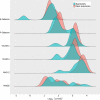Markers of endothelial and epithelial pulmonary injury in mechanically ventilated COVID-19 ICU patients
- PMID: 33608030
- PMCID: PMC7894238
- DOI: 10.1186/s13054-021-03499-4
Markers of endothelial and epithelial pulmonary injury in mechanically ventilated COVID-19 ICU patients
Abstract
Background: Biomarkers can be used to detect the presence of endothelial and/or alveolar epithelial injuries in case of ARDS. Angiopoietin-2 (Ang-2), soluble intercellular adhesion molecule-1 (ICAM-1), vascular cell adhesion protein-1 (VCAM-1), P-selectin and E-selectin are biomarkers of endothelial injury, whereas the receptor for advanced glycation end-products (RAGE) reflects alveolar epithelial injury. The aims of this study were to evaluate whether the plasma concentration of the above-mentioned biomarkers was different 1) in survivors and non-survivors of COVID-19-related ARDS and 2) in COVID-19-related and classical ARDS.
Methods: This prospective study was performed in two COVID-19-dedicated Intensive Care Units (ICU) and one non-COVID-19 ICU at Ferrara University Hospital. A cohort of 31 mechanically ventilated patients with COVID-19 ARDS and a cohort of 11 patients with classical ARDS were enrolled. Ang-2, ICAM-1, VCAM-1, P-selectin, E-selectin and RAGE were determined with a bead-based multiplex immunoassay at three time points: inclusion in the study (T1), after 7 ± 2 days (T2) and 14 ± 2 days (T3). The primary outcome was to evaluate the plasma trend of the biomarker levels in survivors and non-survivors. The secondary outcome was to evaluate the differences in respiratory mechanics variables and gas exchanges between survivors and non-survivors. Furthermore, we compared the plasma levels of the biomarkers at T1 in patients with COVID-19-related ARDS and classical ARDS.
Results: In COVID-19-related ARDS, the plasma levels of Ang-2 and ICAM-1 at T1 were statistically higher in non-survivors than survivors, (p = 0.04 and p = 0.03, respectively), whereas those of P-selectin, E-selectin and RAGE did not differ. Ang-2 and ICAM-1 at T1 were predictors of mortality (AUROC 0.650 and 0.717, respectively). At T1, RAGE and P-selectin levels were higher in classical ARDS than in COVID-19-related ARDS. Ang-2, ICAM-1 and E-selectin were lower in classical ARDS than in COVID-19-related ARDS (all p < 0.001).
Conclusions: COVID-19 ARDS is characterized by an early pulmonary endothelial injury, as detected by Ang-2 and ICAM-1. COVID-19 ARDS and classical ARDS exhibited a different expression of biomarkers, suggesting different pathological pathways. Trial registration NCT04343053 , Date of registration: April 13, 2020.
Keywords: Acute respiratory distress syndrome; Angiopoietin-2; Biomarkers; COVID-19; Intercellular adhesion molecule-1; Receptor for advanced glycation end-products; Selectin; Vascular cell adhesion protein 1.
Conflict of interest statement
The authors declare that they have no competing interests.
Figures


References
Publication types
MeSH terms
Substances
Associated data
LinkOut - more resources
Full Text Sources
Other Literature Sources
Medical
Research Materials
Miscellaneous

